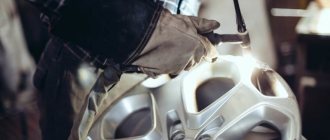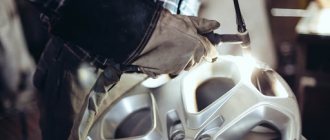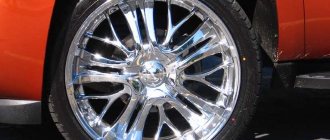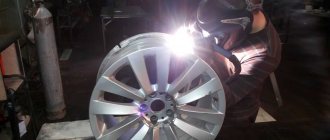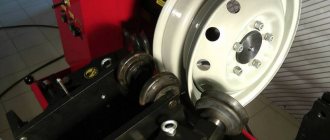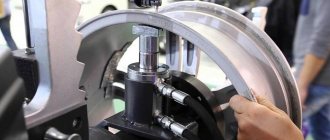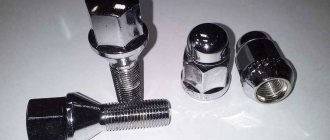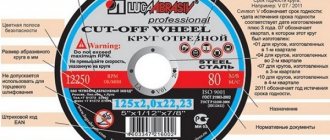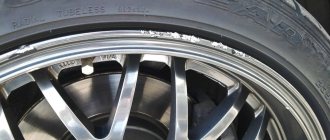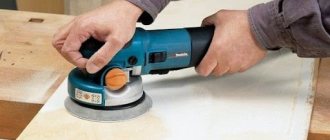Today, I will tell you and show you how to properly weld an alloy wheel using my “technology”. As usual, aluminum is capricious in terms of surface cleanliness - we clean it, degrease it, etc.
And so - a disk with a crack.
The repair area is cleaned in all planes... And degreased, if necessary.
Then a penetrant is applied (penetration control kit. PVK)
We take the second can from the kit and apply the developer...
And we see how the defect is revealed (which was previously difficult to notice)…
After 7-10 minutes, the penetrant appears completely on the surface of the developer and it becomes possible to understand the nature and direction of the defect.
We saw the disc strictly according to the defect, adding about 10-15mm to the length of the saw...
After this, we remove the traces from the penetrant control and proceed to welding... We start from the inside of the disk, from the spokes to the rim (so that shrinkage stresses do not accumulate). We make a backing weld; first, you can “walk” with an arc along the cut edges of the disk in order to avoid possible defects getting into the base metal...
We turn the disk over and clean it again, but this is a new seam...
After everything has been cleaned and traces of oxides have been removed, WITHOUT additives, we “stir” them with an arc - one cutting wall to the other and a lining seam...
Next, we begin to fill in the “former” cutting thickness...
We get a seam of this type...
After this, we assemble the tire, inflate it to 4-5 bar and once again look at “poisoning/not poisoning” - at the point of contact between the tire and the disk.
Thank you all for your attention! This concludes the lesson on high-quality aluminum wheel repair!
For vehicles traveling on Russian roads, hitting a wheel on a pothole is a common thing. Car owners know that every such hit is fraught with damage to the support rim. Driving with damaged wheels is unsafe. Cast and forged wheels are made from two alloys:
- aluminum-silicon contain from 7 to 12% and magnesium;
- AlSiMg alloy is more ductile, has been used since the 80s, and contains from 11 to 15% magnesium.
Pure aluminum is not currently used. To restore the integrity of the metal, welding of disks with argon is usually used. Many service stations do this kind of work.
Repairs can be carried out in the garage. It is permissible to weld a cast disk without a protective atmosphere using the electric arc method. The connection is not very reliable, but further destruction of the aluminum part by electrode surfacing can be stopped.
Types of damage
Cast wheels bend more easily, while forged ones are more fragile. Dynamic overloads have a destructive effect on metal. On the rim appear:
- curvature;
- deep axial faults;
- cracks in the hub area (they cannot be repaired);
- chips.
It is important to ensure the integrity of car rims, maintaining the circumference, so that the wheel does not become eight - the load on the rim will increase. Repairs begin with editing. When mechanically repairing a rim, structural defects of varying depths and types often appear on the metal. Cracks and chips are eliminated by surfacing with preliminary cutting.
Repair and welding of car wheels
The most common problem that motorists face is cracks. Chips are possible, they require more attention, since in fact the disk has to be assembled from two parts, making sure that its geometry is not disturbed.
Discs without defects
When repairing cracks and chips, preparation is first made:
- Contaminants in the repair area are removed.
- The paint is peeled off at a distance of 1 cm from the damage site.
- A cut is made along the crack - the so-called “opening”, which helps to level the metal in the area of the defect and, as a result, will provide a better result.
Another option would be to drill where the crack ends and cut from the outer edge to where you drill.
The sequence of actions when repairing and welding a car wheel is as follows:
Disk repair
- After removing the tire, you need to carefully inspect everything, marking all the chips and cracks (some may be very small).
- Clean the coating down to bare metal around the work area.
- Using a grinder or other tool, cut through the crack areas.
- Clean and degrease the area of the future weld.
- Carry out welding using filler wire and argon arc welding.
- After the weld has cooled, grind it flush with the surface.
Which welding method to use to weld a cast disk?
The choice of method depends on the equipment available in the garage:
- Repairing cast wheels with argon involves welding a rod to the defect. In a protective atmosphere, hot metal does not oxidize. The seam is tight.
- If you have an inverter and you can organize the supply of inert gas, argon arc welding is possible. It requires a tungsten refractory electrode and an additive. The seam is more accurate than with an arc one.
Welding of discs at service stations is carried out using the second method using semi-automatic machines that ensure uniform supply of the additive. After this, the rim is checked for geometry - symmetry deviations are identified.
Types of disks
The disc is the part of the wheel on which the rubber tire fits. Discs can be made from different materials and using different technologies, which will determine their properties. The most common are stamped discs, for the manufacture of which carbon steel is used.
They are made of two parts - the central one and the rim, which are then combined with each other by welding. After joining, the discs are coated with enamel to protect them from environmental influences. This is a budget option, since the cost of stamped discs is not too high, although they are not particularly beautiful. Stamped wheels are installed on new cars coming out of production, which reduces their cost.
Due to the fact that materials that provide softness and plasticity are used in the manufacture of stamped disks, they can be classified as products with high maintainability. When operating a car, this becomes a significant advantage.
When mechanical shocks occur, the disk is crushed and its shape changes. At the same time, he absorbs the main part of the blow, partially dampening it. The modified disk is subject to restoration, in particular, repair of disks by welding is used. The disadvantage of stamped discs is their heavy weight. This can lead to poor performance and increased gas mileage.
Alloy wheels are a single piece made by casting. Aluminum-based alloys are mainly used for their manufacture. Steel is unsuitable for this. In order for cast wheels to gain greater strength, they are subjected to hardening, which relieves residual stress. After this, the discs are varnished.
The big advantage of alloy wheels is their low weight. As a result, the load on the vehicle's suspension is reduced, which increases its stability and ease of control. The suspension wears out less. Due to the reduction in shocks, the ride comfort in such a car increases. Due to the fact that there are no caps in the internal part, the brake system can cool naturally. The use of aluminum provides increased corrosion resistance. In this way, the initial costs are compensated.
However, the strength obtained during hardening leads to fragility of the product. If the car receives an impact, the alloy wheel will not bend, but will crack or split. In this case, alloy wheels will need to be repaired by welding.
Forged wheels differ from cast wheels in their manufacturing technology.
The material for them is light aluminum alloys with the addition of magnesium. The manufacturing technology is hot stamping. The resulting blanks are then machined to achieve the desired design.
The beauty of forged wheels is combined with lightness and strength. An important quality is plasticity. If the machine receives a strong blow, the forged disc will not crack, but will become crumpled. This will ensure the possibility of its restoration, which will be ensured by welding forged wheels.
Welding technology for cast wheels
Like any aluminum, a cast or forged rim must be welded in a protective atmosphere. It is useless to seal cracks in air; the first blow will cause the seam to burst. Before welding the disc, the surface needs to be prepared:
- chips and cracks of any depth are pre-cut;
- drill the ends of the cracks to relieve the internal stresses of the metal;
- clean off the strong oxide film with an abrasive, the joint should shine;
- degrease the edges with solvent.
If a patch is needed, a different rim can only be used after matching the alloys. It is indicated on the label. Only homogeneous compounds are combined.
Welding of aluminum alloys with consumable electrodes OK 96.50:
- after preparing the surface, the working area is heated with a blowtorch or gas torch to 300°C, tarnish spots should appear on the metal;
- the electrode is preheated to 150°C, it will ignite better;
- the patches are first grabbed on both sides, then the seams are welded;
- deep cracks are sealed from the inside, the molten metal should come out.
Argon welding of cast aluminum discs is carried out with reverse polarity so that the gas is ionized. The tungsten electrode is connected to the minus:
- argon is supplied to the working area only after ignition of the arc, after 10–15 seconds;
- the optimal distance between the surface and the electrode is 1.5 mm;
- after attenuation, do not immediately turn off the argon supply, leave it for 10 seconds for the seam to set;
- the filler wire is selected according to the thickness of the metal in the defect zone; it is always one position smaller;
- the additive supply speed is average; when fast, the metal begins to spark; it is introduced in front of the burner, at an angle to the electrode and surface.
Welding of aluminum disks with an inverter is carried out with the “Down Slope” function enabled, which ensures a smooth attenuation of the arc.
Useful tips from welders
For those who are attempting to weld a cast disc for the first time, recommendations from people with experience will help.
How to choose filler wire?
The alloys used by wheel manufacturers vary in chemical composition. Experts are guided by the type of defects:
- alloys with a high silicon content are more likely to burst and bend less often - wire with silicon is needed for repairs;
- aluminum alloyed with magnesium, ductile - when the rim is bent, it is better to choose soft rods.
How to separate defects?
Cracks on thick parts are cut on both sides in the form of the letter X. For defects up to 3 mm deep, V-shaped edges are made. At the ends of cracks, small holes up to 2 mm in diameter are drilled to relieve internal stresses. When the side is chipped, the broken area is leveled with a grinder. It is recommended to cut through longitudinal cracks before surfacing so that they do not crack further. It is enough to cut through the transverse ones to align the edges.
How to repair chips?
The number of layers depends on their depth. The seam is made discontinuous, no more than 3 cm long. The stitches of the next layer are perpendicular to the previous one. The roller is made in stock so that there are no indentations left after sanding before painting.
From which side should the cracks be sealed?
First with the inside. The roller should extend 1 cm beyond the edges. Longitudinal cracks are sealed first; transverse cracks are not so dangerous. They are smelted last. The unsuccessful seam is cut with a grinder and the metal is boiled again.
What regime should I follow?
Argon welding is carried out at high currents, up to 120 A. For thick parts of the rim, the current is increased to 140 A. The alternating current balance is from 55 to 60%.
When repairing the rim yourself, it is important to follow the recommendations and strictly follow the aluminum welding technology. Before painting, the seam is carefully leveled. Don't forget about safety: high-speed driving on a restored rim is unsafe.
Alloy wheels are considered indestructible. But their welding is advertised everywhere. Because each product is initially designed for certain operating conditions and mode.
Welding process
For welding light alloy wheels, a reverse polarity mode is used.
| Rod | Application |
| 1070 | AD1, Amts |
| 1100 | AD1, Amts |
| 1450 | With the addition of titanium. Used for welding aluminum and its alloys in aircraft construction and the food industry. |
| 4043 | For welding cast Al and Si alloys AD31, AD33, AD35 (ICE blocks, base plates, frames, etc.) |
| 4047 | With the addition of silicon to increase fluidity and reduce shrinkage deformations |
| 5087 | With the addition of Zn to reduce the likelihood of hot cracks. Suitable for welding AL alloys containing up to 5% Mg |
| 5183 | Food industry, marine shipbuilding. For Al-Mg welding; Al-Mn alloys. |
| 5356 | AMg3, AMg4, AMg5, AMg6 |
| 5554 | Tanks for storing chemical materials, car frames and rims. |
| 5556 | For welding Al-Mg T-joints. |
| 5754 | For welding Al-Mg alloys. The seam has high strength and resistance to corrosion. |
A ground is connected to the disk, and a positive potential is applied to the electrode. In this case, the area of increased temperature is localized near the electrode, eliminating excessive overheating of the welded area of the disk.
The inverter sets the welding current. Welding of thin areas of the disk is carried out at a current of up to 120 A, and for the thicker part it increases to 140 A.
To form a protective inert environment, the argon supply is turned on 15...20 seconds before the start of welding. Argon should also be turned off a little after the welding process is completed - approximately after 5...10 seconds.
After applying the operating current, the torch with the electrode is brought as close as possible to the surfaces to be welded, but without contact. The optimal distance would be about 2 mm. Holding the electrode at this distance will allow you to warm up the parts being connected well (without overheating them), obtaining a high-quality and highly reliable seam.
The torch with filler wire should be moved slowly along the direction of the weld being formed. The filler wire is inserted into the arc action area without sudden movements.
During welding, care must be taken not to touch the surfaces being welded with the electrode. Electrode contact with the surface can contaminate the arc and make welding difficult.
To ignite the working arc, oscillators are used, which convert the mains current into high-frequency pulses with a voltage of 2...6 kV and a frequency of 0.15...0.5 kHz. Pulses with such parameters allow you to quickly ignite the arc without the need for contact of the electrode with the surface to be welded.
Types of damage
Chips and cracks may appear on alloy wheels.
Repairing these damages in specialized workshops will significantly impact your wallet. The price is based mainly not on the complexity of the work performed, but on the fact that the market for such services is not wide. But doing the repair yourself will be much cheaper. You should know that argon welding is used to eliminate these damages. When welding with argon, unlike conventional welding, the electrode is not inserted into the holder. It must be brought into the flame of an argon burner. The process is very similar to soldering rather than welding:
- The surfaces being welded heat up.
- Molten metal is poured between them.
This is a general description of welding. There are no difficulties in this process. Therefore, anyone who has experience in welding will be able to cope with this task. To carry out this work you will need the following tools:
- Protective mask and other protective equipment.
- Special electrodes (their composition must match the material from which the cast disk is made. The composition of the disk can be determined by the markings).
- Argon welding machine.
- Bulgarian.
Selecting welding type and electrode
A very important step is the choice of electrode.
This is not easy to do, because deviations from the specified composition may result in undesirable consequences. Very often there were cases when, after welding cast wheels in specialized workshops, they were recommended to be used only for a spare wheel. The master selected the wrong type of electrode for welding - this is precisely why the welding seam turned out to be unreliable.
There are two types of argon welding:
- With manual electrode supply.
- With automatic feeding.
The automatic device is positioned as a more modern and reliable technology. True, its disadvantage is that only a specialist can work with it. To be more precise, only an experienced user will be able to configure the device correctly for a certain brand of alloy.
It will be easier for an ordinary person to cope with a cheaper device in which the electrode is supplied manually. Its work is no worse than automatic, but it’s much easier to get used to it.
Surface preparation
Welding cast wheels with argon begins with surface preparation.
In order to simply weld a crack, you will need to widen it a little and remove paint from the surface of the disk at a distance of at least 1 centimeter from the crack in both directions. If it is necessary to repair a chip, then you will need to work hard on the disk and the piece that will be welded to it.
The ideal option is when the piece is part of the same disk. But if you are going to weld a piece from another disk, then first you need to double-check the composition of the surfaces that will be welded.
In this case, if the material is incorrectly selected, all the work will be in vain. It is not at all difficult to adjust the borrowed piece to the size of the chip. For these purposes, it is necessary to glue a sheet of paper to the damaged part and outline the boundaries of the chip with a pencil. Place the paper on the part you are going to weld and transfer the resulting outline to the surface. It is along them that the patch is cut.
Parts at the chip site and welding site are cleaned of irregularities and paint at a distance of at least 1 centimeter. This is done using a grinder. It will be difficult to remove paint from the product using other methods. Because this paint has a specific composition and adheres well to the surface. The paint will burn during the welding process, emitting a large amount of very acrid smoke. It is because of this that it is necessary to weld rims in a room where there is good exhaust or which is well ventilated.
Why is it important to properly weld the disk with argon?
Welded crack
Welding cast wheels is now a fairly popular service, so many installers offer it without having sufficient skills or “learning in the era of enlightenment.” Such cases are not uncommon, and an aluminum wheel can be “highly and quickly, in 5 minutes” repaired on the side of the road near the highway. When choosing, it is necessary to focus on such companies with experience as, for example, RLD-groups.
While the car is moving, the disk on the axle rotates at high speed and experiences considerable loads. The quality of the weld seams and the preliminary preparation of the additive before welding are important.
Poor quality filling of the welded cavity with filler material may occur. In the cavity, at the border of contact between the disk and the weld, cavities can appear, places where the metal is poorly connected, which can collapse if there is a change in temperature or a physical shock (falling into a hole, overcoming a speed bump at high speed).
You might be interested in this About the rear wheel hub and its repair
The welding of discs with light alloy wire should be carried out after the correct preparation procedure and in compliance with the technology. Simply placing a weld over an existing crack is completely unacceptable.
Work order
After preparing the surface and gaining at least some experience, you can begin repairing the discs. The operating procedure is as follows:
- Warm up the welding area with a torch . In this case, you need to ensure that the metal does not overheat.
- Apply the electrode to the seam after a certain color appears (it depends on the material of the product). If you follow all the rules, the metal from the electrode will melt quickly and fill the seams.
- When welding a disc chip, it doesn’t hurt to grab it around the edges. This will secure the position of the patch. After this, you can weld the elements along their entire length.
- the seam should be visible on both sides. Liquid hot metal must fill the space completely and enter the metal structural lattice of the disk.
If the disk is thick, welding is carried out in several stages on both sides. The seams are overlapped. This type of welding is much more reliable. After the disc has completely cooled, it should be sanded and prepared for painting. A grinder with grinding and sharpening attachments will help you with this. After complete surface treatment, the cast restored disc is ready for further use.
general information
As we wrote above, alloy wheels are very popular. Manufacturers offer many shapes and colors of discs. Such discs do not need hubcaps like stamped ones, and they have no visual defects. Any expensive car cannot be sold without alloy wheels.
Modern wheels are made from an alloy of aluminum and magnesium. Previously, the wheels were entirely aluminum, but over time it became clear that the quality of aluminum wheels is imperfect. They were not resistant to increased mechanical loads and quickly deformed, especially off-road. Therefore, magnesium was added to aluminum to keep the disc lightweight while improving its performance.
Often no more than 10-15% magnesium is added to the composition. In this case, you need to make sure that the metal grade is indicated on the disk. Knowing the brand, you can easily set up the welding mode, select the necessary electrodes and other consumables
It is very important. All repairs must be made with consumables that are made of the same metal as the disk itself
If this is neglected, the seam will turn out to be of poor quality and will quickly collapse.
Advantages of argon welding
Argon protects the welded surface from the appearance of oxides on it. Sometimes oxygen has to be added to argon. This is necessary when welding requires deep penetration into the product or when the alloy composition has a high melting point. Even in such situations, the metal will be protected, since oxygen burns out during operation.
Argon welding of discs is one of the most popular services, as it is the only method of repair work. Currently, this demand is growing. Therefore, there are more and more specialists in this type of repair. Welding of a damaged car crankcase and other engine parts is carried out in the same way.
Welding tips
Experienced welders give the following advice when carrying out work:
- To prevent abrasive from getting into the seam, it is advisable to cut the part with a milling cutter.
- If you cannot weld the crack in one approach, then you need to cut out the root of the seam from the back side.
- It is better to place copper or stainless steel linings on the reverse side.
- In order to reduce the stress on the part, it is necessary to heat the welded area to approximately 250-300 degrees . Laundry soap will help determine the temperature. To do this, you need to run a bar of soap over the disk and heat it. When the mark turns brown, the temperature on the disk is 250 degrees , and when it turns black, it is 300 degrees .
Technology for repairing cast car wheels with argon
Having driven off-road in a breeze, you have once again damaged the disk on your car.
A swarm of thoughts flashed through my head: what to do, is it possible to weld a car part dear to my heart or will I have to buy a new one?!
Welding disks with argon will help solve this problem! The argon-arc method will eliminate chips and cracks in cast material and even restore a product split in half.
You can turn to professionals who quickly and efficiently perform disk repairs. True, the price for services is not small, for example for Moscow:
- the cost of a welding seam per 1 cm is 150 rubles;
- it will cost 300 rubles per 1 cm to fuse the side of the disk inside;
- 400 rubles - fusing the side from the outside.
To save money, you can restore the product yourself in a garage.
Preparing the disc for welding work
Preparation includes: removing the oxide film, paint, cutting chamfers. You can clean and prepare the edges using a grinder with a 1 mm thin disk and cutters installed.
- A longitudinal crack must be cut through;
- Cut transversely with a slight spread.
Cutting an edge for a transverse crack
V-shaped crack cutting is performed for thin metal, and X-shaped for thick metal. It is recommended to drill the ends of the cracks to relieve stress in the metal. Properly prepared edges will contribute to better penetration of the part.
If a small part of the side edge (side) is missing, the broken area is also cleaned with a grinder.
A piece of side is missing
The filler material is selected according to the composition of the disc. For example:
- if the disk bursts, it means there is a lot of silicon in its composition - silicon wire is taken;
- if it is bent, the composition is dominated by magnesium.
I present to your attention a table with rod numbers and their application:
Connection technology
Argon welding of disks usually begins with fusing the missing part.
The process of restoring a piece of board
When surfacing, a small current strength is set on the device - 120-140 A. For better control of the weld pool, the alternating current balance is 55-60%. To prevent the formation of a crater, the “Down Slope” function of a smooth decrease in current at the end of welding is configured correctly.
For large volumes of surfacing, it is better to use the pulse mode.
The extension is carried out gradually, 1 layer is applied, the second is applied on top and so on. Deposition should be carried out with a margin on the outer and inner sides. The excess will be cut off during processing.
Next, in the process of argon welding, a seam is applied from the inside to the longitudinal and transverse crack. It is necessary that the weld bead extends 1 cm beyond the crack on both sides. Safety net in case of air leakage when installing a tubeless tire.
After welding inside, the disk is turned over - the cracks on the outside are also cleaned, chamfers are cut and subjected to boiling.
Preparation of external cracks
If an incident occurs, you can use a grinder to cut off the weld seam, cut the chamfer again and reapply the seam.
That's it - argon welding of alloy wheels is completed. The painstaking, jewelry work of processing begins.
Part processing includes:
- cleaning edges from excess metal;
- output of the side planes and for the tire landing.
When cleaning, areas with a small amount of deposited filler material may be revealed. To eliminate defects, it is necessary to repeat the surfacing.
Welding tips:
- To reduce stress on the part, the welded area must be heated to 250-300 degrees. Laundry soap will help determine the temperature. Run a bar of soap over the disc and heat; the mark turns brown, which means the temperature is 250 degrees. When the color is black, the heating temperature is already 300 degrees;
- on the reverse side it is better to place linings (stainless steel, copper);
- if it is not possible to weld the crack in one pass, then the root of the seam must be cut out from the back side;
- To avoid abrasive getting into the seam, it is advisable to make cutouts with a milling cutter.
Video:
https://www.youtube.com/watch?v=fZVnOL6VXn8
Repairing a disk with severe deformation
When you get the hang of simple cracks and chips, only then can you take on complex things. For example, if the disk side is severely damaged, welding alloy disks with argon will also help in repair.
Severe damage
First you need to remove the unusable part that cannot be repaired and restore the board configuration.
Search for a donor, find another disk similar in composition, diameter and bead geometry. Cut a similar piece from the donor and fit it to ours.
Fitting the insert
Weld the insert using argon arc welding and restore the bead geometry using a hydraulic press. A lathe is also needed in a home workshop. Which will help to display the circumference of the repaired product with micron accuracy.
PS Argon welding of discs will always be in demand. With our roads, you will have a constant profit.
